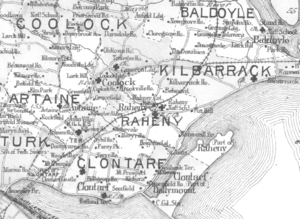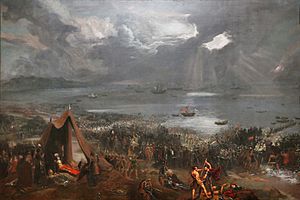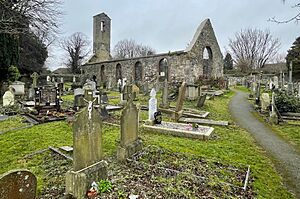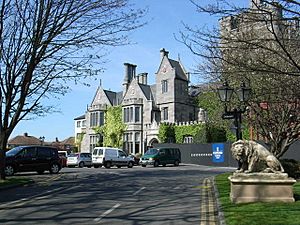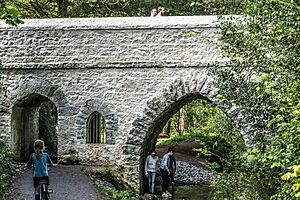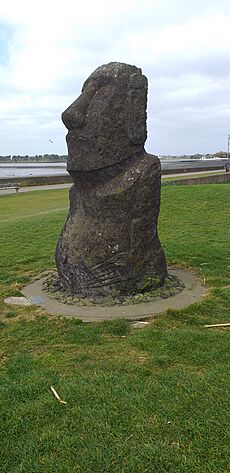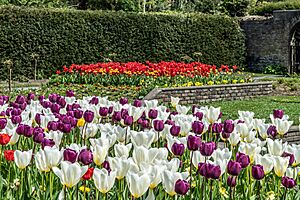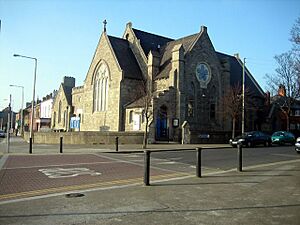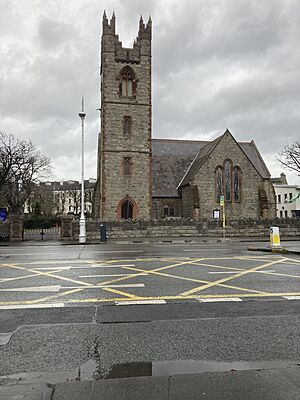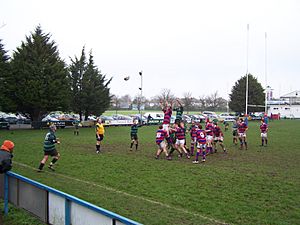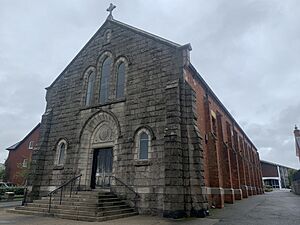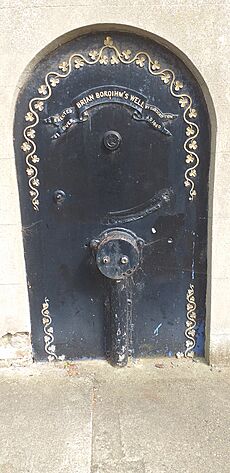Clontarf, Dublin facts for kids
Quick facts for kids
Clontarf
Cluain Tarbh
|
|
|---|---|
|
Suburb
|
|
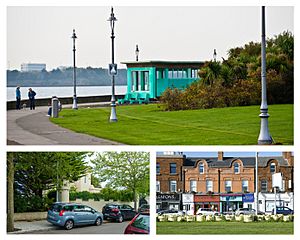
Clockwise from top: Clontarf promenade; businesses along the promenade; Mount Prospect Avenue, Clontarf
|
|
| Country | Ireland |
| Province | Leinster |
| County | Dublin |
| Local authority | Dublin City Council |
| Time zone | UTC+0 (WET) |
| • Summer (DST) | UTC-1 (IST (WEST)) |
Clontarf (Irish: Cluain Tarbh, meaning meadow of bulls) is a lovely coastal area on the north side of Dublin, Ireland. It is known for its beautiful seafront. Clontarf is part of the Dublin 3 postal district.
Long ago, there were two main parts to Clontarf. One was closer to the city along the coast. The other was a fishing village called Clontarf Sheds, further north. Today, Clontarf has many shops and businesses, especially around Vernon Avenue. It is next to areas like Fairview, Marino, Killester, and Raheny. Dublin City Council looks after Clontarf.
Clontarf is famous for the Battle of Clontarf in 1014. In this battle, Brian Boru, who was the High King of Ireland, defeated the Vikings from Dublin and their Irish allies from Leinster. This big battle happened over a wide area. It is seen as the end of the wars between the Irish and the Vikings.
Contents
What Does the Name Clontarf Mean?
The name Cluain Tarbh comes from the Irish language. Cluain means "meadow" and tarbh means "of bulls". So, Clontarf means "meadow of bulls".
Where is Clontarf Located?
Clontarf is on the northern side of Dublin city. It is northeast of the city centre, right along the coast. To the west and south, it borders Fairview Park and the area of Marino. To the north, you'll find Killester and Artane. To the northeast, it is next to Saint Anne's Park and Raheny.
The southern edge of Clontarf is on the estuary of the River Tolka. This is one of Dublin's three main rivers. The Wad River also joins the Tolka estuary near Clontarf's coastline. The Naniken River flows through St. Anne's Park and reaches the sea at the Raheny end of the area. The land in Clontarf is mostly flat, rising slightly as you go inland.
Discovering Bull Island
Bull Island is also shared with Raheny. It is sometimes called North Bull Island. A historic wooden bridge connects it to Clontarf at its northern end, in an area called Dollymount. Most of the island belongs to the city. However, the Bull Wall and its road and path belong to the Dublin Port Company. They close it for one day each year to show this. At the end of the wall, there is a statue of Our Lady, Star of the Sea. This statue watches over sailors and dockworkers.
Clontarf Island: A Lost Landmark
Long ago, there was an island called Clontarf Island off the coast. It was near where the River Tolka meets the sea. Old maps, like one from 1753, show it had a house. People used it for bathing and even as a safe place during a plague in 1650.
Building the Great South Wall and the Bull Wall in Dublin Port changed how water flowed in Dublin Bay. This threatened the island. A big storm in 1844 finally destroyed it.
How to Get to Clontarf
Clontarf is located between the coastal and inland roads that go from Dublin to Howth. Many bus routes serve its seafront, like the 130, 104, and H2. Buses on the Howth Road, such as the H1, H2, and H3, cover the inland parts.
Clontarf used to have its own railway station on Howth Road, but it closed years ago. Now, there is a new station called Clontarf Road railway station. It is the first stop north of the city centre on the Dublin Area Rapid Transit (DART) system. This station is between Clontarf and Fairview.
A Look Back at Clontarf's History
After the Battle of Clontarf in 1014, Brian Boru, the High King of Ireland, was killed. He was found praying in his tent by a Viking named Brodu. After this, there was a lot of fighting among other kings.
Clontarf was peaceful for over 100 years. Then, the Normans arrived in 1172. Soon after, Clontarf was given to Adam de Pheypo. He was a follower of Strongbow. Adam de Pheypo built the first Clontarf Castle.
People have lived in Clontarf since at least the 1100s. Old maps from 1598 show it as "Clantarfe".
The land and church of Clontarf were owned by the Knights Templar. Later, they were owned by the Knights Hospitaller. There was a special holy well in the area until recently. Another spring, called Brian Boru's well, still exists on Castle Avenue.
A large house and a small village were once located where the Clontarf Castle Hotel is now. The house was rebuilt many times. The hotel you see today is mostly from the early 1800s. The tower on the site is a copy of the original Templar building. The old ruined church next to it is from the mid-1600s.
Clontarf Castle was burned in 1641 by Sir Charles Coote, 1st Baronet. This was because the owner, George King, was seen as disloyal. In 1649, Oliver Cromwell gave the castle and land to John Blackwell. He then passed it to John Vernon. The Vernon family lived in the Castle for almost 350 years.
In 1659, only 79 people lived in Clontarf.
Fishing, oyster-catching, and farming were the main jobs for centuries. There was a big fish-curing business at the Sheds, near Vernon Avenue. This area grew into a second village of fishermen and farmers. It is marked on old maps of Dublin Bay. Later, a Roman Catholic church was built there.
In 1837, a report said that the land in Clontarf was "in the very highest state of cultivation." This means it was very well farmed.
Clontarf in the 1800s
In the early 1800s, Clontarf became a popular holiday spot for people from Dublin. They came to swim in the sea or in special hot and cold seawater baths. A horse omnibus service started from the city. Clontarf became a trendy place to live. Many rich and important people lived in large houses there.
Daniel O'Connell, a famous Irish leader, wanted to hold a big meeting in Clontarf. He chose this spot because of its link to the Battle of Clontarf. He wanted to call for the Act of Union to be ended. However, the Prime Minister, Sir Robert Peel, banned the meeting. O'Connell called it off to avoid any violence.
Sir Benjamin Lee Guinness, from the famous Guinness brewery, bought land in Clontarf and Raheny. He combined them to create St. Anne's Estate. Today, parts of this estate form Saint Anne's Park.
By the late 1800s, Clontarf was becoming more like a town. It started as a holiday resort but quickly grew into a suburb of Dublin. A tram line was built along the coast, bringing more activity to the area.
Fun Things to Do in Clontarf
Clontarf's best feature is its seafront. There is a long path called a promenade that runs for 4.5 km. It goes from Alfie Byrne Road to the wooden bridge at Dollymount. From 1911 to 1958, the promenade was improved. Shelters and lifeguard stations were added. Many of these structures were designed by Herbert George Simms in the 1930s.
The promenade is popular with runners, walkers, sailors, and cyclists. One interesting thing you'll see is a copy of an Easter Island Moai statue. This was a gift from the ambassador of Chile. It is located near The Sheds pub.
Clontarf also has a private outdoor seawater swimming pool. It used to be a fun place with hot and cold baths. It closed in 1996 and became run-down. But in 2017, it was rebuilt with a restaurant and bar. It opened in February 2018. For now, only clubs can use the pool for swimming.
There is also a public slipway for boats. It is across the road from the Clontarf Yacht and Boat Club.
Clontarf shares Saint Anne's Park with Raheny. This park has many walking paths and green spaces. It also has sports fields and other fun things to do. There is an Arts Centre in the Red Stables. It has artists' shops, studios, a coffee shop, and markets on some weekends. There is also a large rose garden next to the Gaelic Athletic Association (GAA) pitches.
Clontarf also has access to the North Bull Island in the area called Dollymount. The island has Dollymount Strand, a lovely beach, and two golf courses. The island is also famous for its wildlife. The lagoon and mudflats between the island and the mainland are great for birdwatching.
Clontarf has many businesses. You can find a supermarket on Vernon Avenue. There are also pubs, restaurants, convenience stores, banks, pharmacies, and doctors. Dublin Bus has a bus depot on Clontarf Road. It was one of the first six depots for Dublin Bus when it started in 1987.
Schools in Clontarf
Clontarf has several primary schools. The Belgrove National School group is on Seafield Road West. Greenlanes NS is for both boys and girls. Howth Road NS is also for both boys and girls. The Belgrove group has four separate schools on one campus.
For older students, there is Holy Faith Secondary School, Clontarf for girls. Mount Temple Comprehensive School is for both boys and girls. Other popular schools nearby include St. Paul's College, Raheny for boys and Belvedere College S.J. in the city centre.
Special education facilities are available at the Central Remedial Clinic and the Irish Wheelchair Association.
Churches in Clontarf
Today, Clontarf has three Roman Catholic parishes. It also has a Church of Ireland Parish of Clontarf, a Presbyterian church, and a Methodist church. There is a ruined church near Clontarf Castle. The current Catholic Church of St Anthony is built behind the old St Anthony's Church, which is now used as a hall. This old building used to be Clontarf Town Hall.
Historically, Clontarf had a strong Protestant community. In 1911, about 39% of the people in Clontarf were Protestant. Relations between all faith groups have always been good in Clontarf.
Sports and Clubs in Clontarf
Clontarf has many sports clubs. People play rugby, soccer, golf, cricket, sailing, and Gaelic games.
Clontarf has a strong rugby club. The Clontarf Cricket Club Ground is at the same place as the rugby club. It has hosted many international cricket matches. It is the home ground for the Ireland cricket team in the Republic of Ireland.
Clontarf is home to several GAA clubs. They compete in Gaelic football, ladies' football, hurling, and camogie. Clontarf GAA started in 1961. They play their home matches at St Anne's Park. Scoil Uí Chonaill CLG is also in Clontarf and has been competing since 1953.
The area also has two tennis clubs: Clontarf Lawn Tennis Club and Clontarf Parish Lawn Tennis Club.
Clontarf Taekwon-do Club started in 2013. The club competes in Taekwondo at national, international, European, and World levels.
Sailing has been a part of Clontarf for a long time. The Clontarf Yacht & Boat Club is one of the oldest yacht clubs in Dublin Bay. The area for sailing is affected by tides, which means sailing is only possible for certain hours each day.
In the 1930s, Clontarf was a base for Hydroplane racing. This racing likely happened in the "Blue Lagoon" between Bull Island and Dollymount.
The Clontarf Scout Troop was started in 1931.
Clontarf is also home to the Central Remedial Clinic and the Incorporated Orthopaedic Hospital of Ireland. It also has a major centre for the Irish Wheelchair Association.
How Clontarf is Governed
The areas of Clontarf, Dollymount, and Ballybough were once joined. They formed a township managed by town commissioners. This happened under the Clontarf Township Act of 1869. The commissioners built Clontarf Town Hall, which was finished in 1896. This building is now called St Anthony's Hall. In 1900, Clontarf became part of the city of Dublin.
Clontarf is an important part of the Clontarf local electoral area. This is how people vote for members of Dublin City Council.
For national elections, Clontarf is in the Dáil constituency of Dublin Bay North.
Interesting Facts About Clontarf
On Castle Avenue, there is a water outlet in a wall. People believe it comes from a spring called Brian Boru's well. It is said that Brian Boru's men drank from this well during the Battle of Clontarf.
Clontarf was the original home of the Grove Social Club disco. It started in 1967 in Mount Prospect Avenue. It moved to St. Pauls College in Raheny in 1975.
Along the coastal promenade, there is a round rain shelter. This shelter covers an old lead mine. The mine went out under the shallow waters of the bay. It had to close because it kept flooding.
Famous People from Clontarf
Many well-known people have lived in or are from Clontarf:
- Sharon Ní Bheoláin, a TV presenter.
- Harry Boland and Gerald Boland, important figures in Irish history.
- Richie Boucher, a former bank chief executive.
- Joe Duffy, a popular broadcaster.
- Barry Fitzgerald and his brother, Arthur Shields, famous actors.
- Arthur Edward Guinness, 1st Baron Ardilaun, from the Guinness brewing family, was born here.
- Cian Healy, an Irish rugby international.
- Neil Jordan, a film director and writer.
- Phil Lynott, the musician from Thin Lizzy.
- Jack McCaffrey, a Dublin Gaelic footballer.
- Brian O'Driscoll, a former Ireland rugby captain.
- Maureen Potter, a beloved actress and comedian.
- Gerry Ryan, a well-known radio DJ.
- Erwin Schrödinger, a famous scientist, lived here.
- Bram Stoker, the author of Dracula, was born in Clontarf.
- Marty Whelan, a DJ and presenter.
|
See also
 In Spanish: Clontarf para niños
In Spanish: Clontarf para niños



